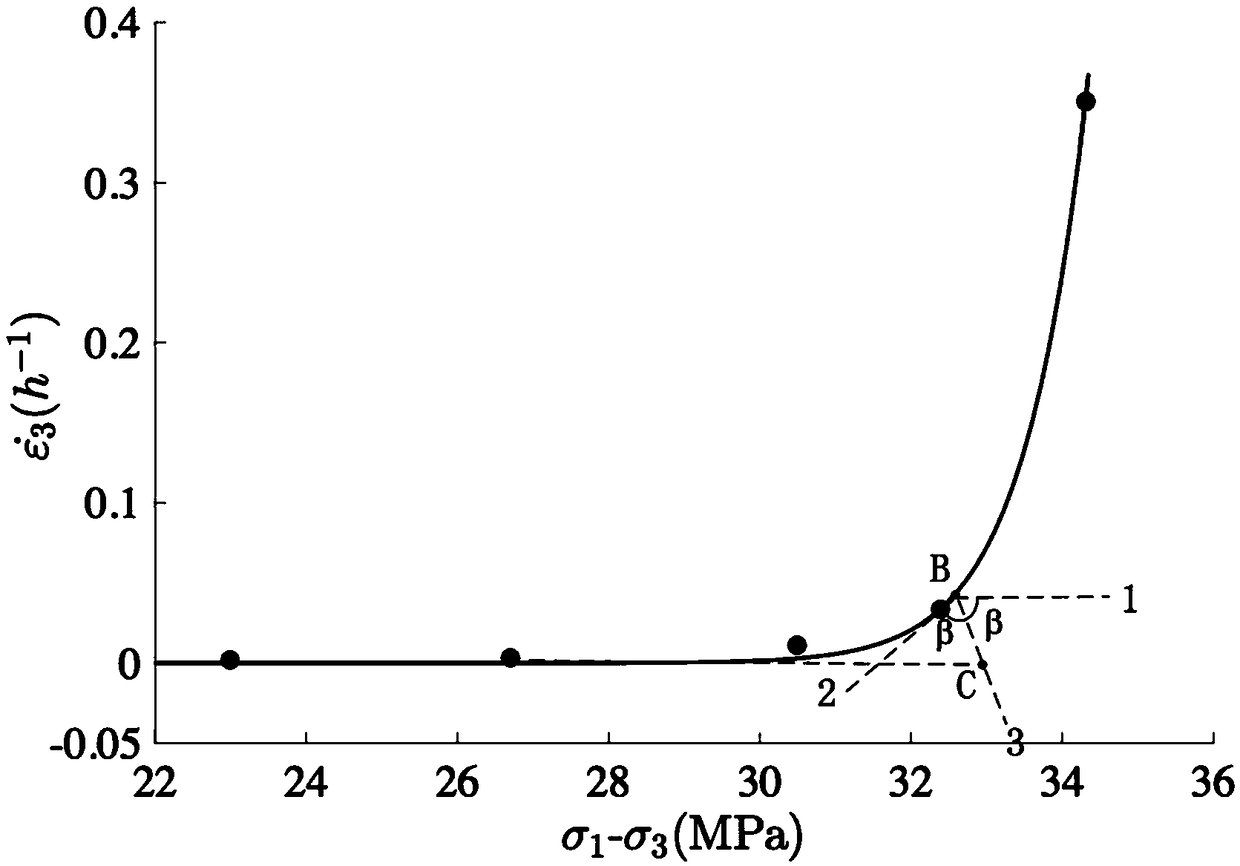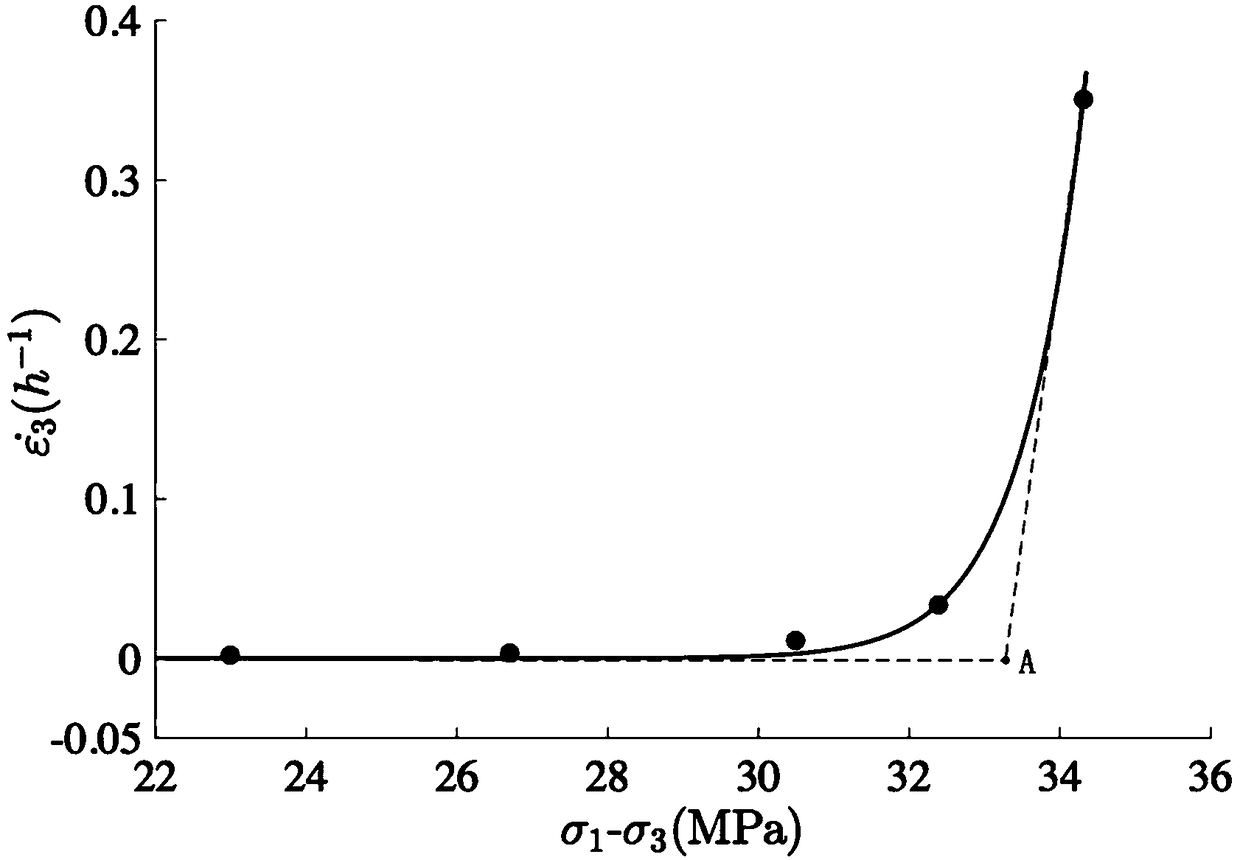A method for determining long-term rock strength parameters based on the Casa Grande method
A technology for long-term strength parameters and determination methods, applied in strength characteristics, using stable tension/pressure to test material strength, instruments, etc., can solve problems such as fuzzy inflection points of curves, errors, etc., to reduce data errors, reduce errors, reduce dependent effect
- Summary
- Abstract
- Description
- Claims
- Application Information
AI Technical Summary
Problems solved by technology
Method used
Image
Examples
Embodiment 1
[0032] The invention provides a method for determining long-term rock strength parameters based on the Casa Grande method, comprising the following steps:
[0033] 1) Make samples;
[0034] A complete and defect-free red sandstone block was selected, a core was drilled with a coring machine, and the core was processed to prepare a cylindrical rock standard sample with a diameter of 50 mm and a height of 100 mm.
[0035] 2) Triaxial creep mechanics test;
[0036] Through the fully automatic triaxial rheological servo instrument and the multi-stage loading method, the triaxial creep mechanics test is carried out on the rock standard sample under the set confining pressure of 6MPa, and the triaxial creep test results are obtained; among them, The results of the triaxial creep test include the deviatoric stress values at each level and the steady hoop strain rate values at each level.
[0037] There is also a single-stage loading method for the triaxial creep mechanics test....
Embodiment 2
[0049] The long-term strength parameters of the rock were obtained by the traditional steady-state rate method, specifically, the preparation of the rock sample in Example 2, the steps and precautions of the triaxial creep test, and the acquisition of the steady-state hoop strain rate-stress level relationship curve The method is the same as that of Example 1, except that the method of processing the curve to obtain the long-term strength parameter is different.
[0050] like image 3 As shown, the traditional steady-state rate method extends the upper and lower straight line segments of the steady-state strain rate-stress level relationship curve to point A, and takes point A as the inflection point of the curve, then the magnitude of the partial load corresponding to the abscissa of point A 33.4MPa is used as the value of the long-term strength parameter of the red sandstone used in this implementation case under the confining pressure of 6MPa.
Embodiment 3
[0052] The long-term strength parameters of the rock are obtained by the traditional stress-strain isochrone curve method, specifically, the preparation of the rock sample in embodiment 3, the steps and precautions of the triaxial creep test are the same as in embodiment 1, the difference is that the three The method of processing the curve obtained from the shaft creep test results and the method of processing the curve to obtain the long-term strength parameters are different.
[0053] In embodiment 3, the triaxial creep test result is processed to obtain the stress-strain isochronous curve, such as Figure 4 shown. The stress-strain isochrone curve method uses the partial load at the inflection point of the isochrone curve as the long-term strength parameter. Through visual inspection, point D is determined to be the inflection point of the isochrone curve in this implementation case, and the magnitude of the partial load corresponding to its abscissa is 32.2MPa as the val...
PUM
| Property | Measurement | Unit |
|---|---|---|
| diameter | aaaaa | aaaaa |
Abstract
Description
Claims
Application Information
 Login to View More
Login to View More - R&D
- Intellectual Property
- Life Sciences
- Materials
- Tech Scout
- Unparalleled Data Quality
- Higher Quality Content
- 60% Fewer Hallucinations
Browse by: Latest US Patents, China's latest patents, Technical Efficacy Thesaurus, Application Domain, Technology Topic, Popular Technical Reports.
© 2025 PatSnap. All rights reserved.Legal|Privacy policy|Modern Slavery Act Transparency Statement|Sitemap|About US| Contact US: help@patsnap.com



